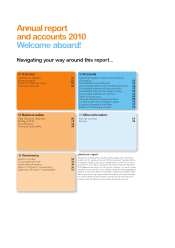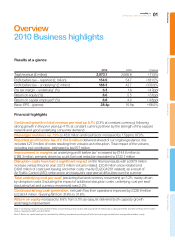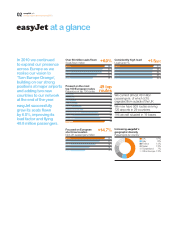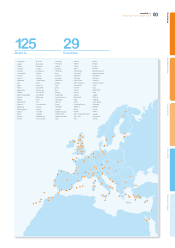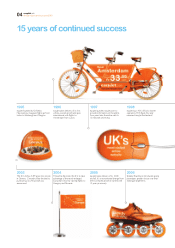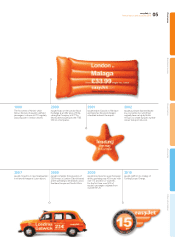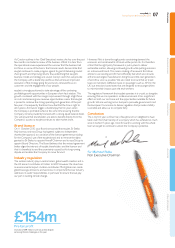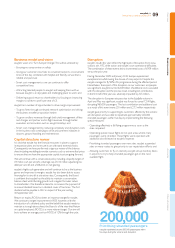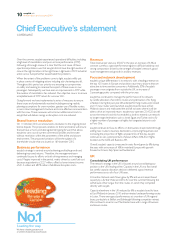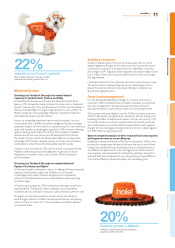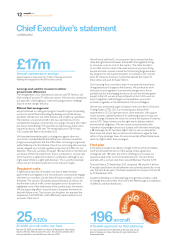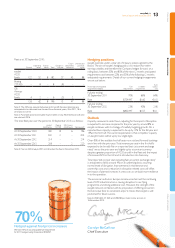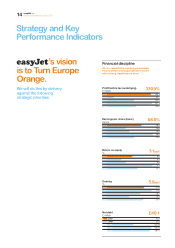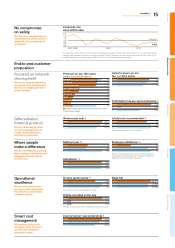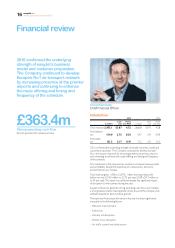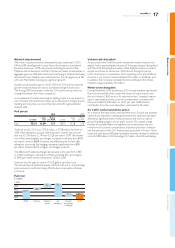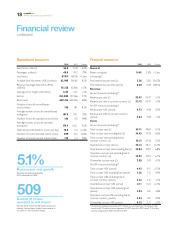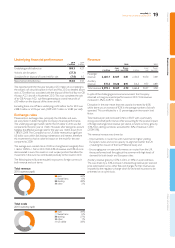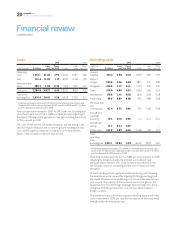EasyJet 2010 Annual Report Download - page 12
Download and view the complete annual report
Please find page 12 of the 2010 EasyJet annual report below. You can navigate through the pages in the report by either clicking on the pages listed below, or by using the keyword search tool below to find specific information within the annual report.
Over the summer, easyJet experienced operational difculties, including
a high level of cancellations and poor on time performance (OTP).
Following a thorough review, it is clear that the root cause of these
operational problems was that easyJet did not have the right number of
crew in the right locations at the right times. High levels of ATC industrial
action across Europe further exacerbated the problems.
When the extent of the problems came to light, easyJet swiftly put
inplace a series of mitigating actions including sub-chartering aircraft.
Throughout this period our priority was ensuring no compromises
onsafety and seeking to minimise the impact of these issues on our
passengers. Subsequently, we have seen an improvement in OTP while
the number of cancellations has reduced. Our objective now is to ensure
acceptable levels of OTP return for summer 2011.
Going forward we have implemented a series of measures to ensure
these issues are fundamentally resolved including ensuring realistic
planning assumptions for crew numbers, greater use of exible rosters,
amore robust management structure and more effective communication
with the crew. These measures will not incur additional net costs to
easyJet but will deliver savings as disruption costs are reduced.
Brand licence resolution
On 11 October 2010, we announced a resolution to the ongoing brand
licence dispute. The proposed variations to the brand licence will ensure
that we have a more workable agreement going forward that allows
easyJet to carry out all current commercial activities and innovate
without restriction within the parameters of the airline and airport
environment. The proposed variations will be the subject of a
shareholder circular that was issued on 16 November 2010.
Business performance
easyJet’s strategy is centred around achieving protable growth and
delivering improved returns. Therefore, the management team
continually focuses its efforts on both driving revenue and managing
costs. Margins improved in the period, mainly driven by a unit fuel cost
decrease equivalent to £122.7 million, offset by lower interest income
of £11.3 million and £97.9 million of additional disruption costs.
Revenue
Total revenue per seat was £53.07 in the year, an increase of 3.3% at
constant currency; a good performance against a difcult backdrop and
strong comparators driven by the strength of easyJet’s network, good
route management and growth in ancillary revenues.
Focused network development
easyJet’s unique differentiator is its network, with a leading presence on
the top 100 routes in Europe and positions at primary airports that are
attractive to time sensitive consumers. Additionally, 53% of easyJet’s
passengers now originate from outside the UK, an increase of
3percentage points compared with the prior year.
easyJet has continued to manage the performance of its network
bycareful allocation of aircraft to routes and optimisation of its ying
schedule. During the past year, 28 underperforming routes were closed
and 115 new routes were launched. easyJet closed its base at East
Midlands airport and reallocated the aircraft to bases where it will be
able to drive an improved return. easyJet now operates 25 A320 aircraft
across the network and this has enabled us both to extend our network
to longer range destinations such as Israel, Egypt and Turkey and to y
ahigher number of passengers at highly slot congested airports such
asParis Orly.
easyJet continues to focus its efforts on the business travel market through
adding new routes to business destinations, improving frequencies and
increasing the proportion of ights at peak times of the day. easyJet
continues to see a yield premium of about 20% to 30% from ights
booked via the GDS and Business API.
Overall, easyJet’s capacity (measured in seats own) grew by 6% during
the year, with an increase of 16% in mainland Europe with growth
focused on France, Italy, Spain and Switzerland.
UK
Consolidating UK performance
The network strategy in the UK is focused around consolidating our
position as the UK’s leading airline. Capacity in the UK was at overall
butcareful capacity allocation decisions delivered a good revenue
performance across all of our UK bases.
At London Gatwick seats own grew by 9% and we increased based
capacity by a further three aircraft to 42 over the summer following the
withdrawal of Aer Lingus from the routes on which they competed
directly with easyJet.
Capacity elsewhere in the UK reduced by 6% as easyJet closed its base
atEast Midlands in January 2010 and terminated underperforming routes
in Luton. There were good performances at a number of UK regional
bases, particularly at Belfast and Edinburgh following competitor retreat.
We continue to invest in our Manchester base with a range of business
and leisure routes.
Chief Executive’s statement
continued
Leading the way
We have a leading presence at
a number of airports across Europe.
N o.1
10 easyJet plc
Annual report and accounts 2010


